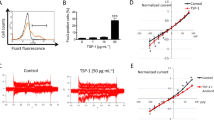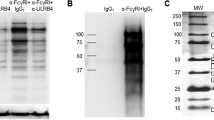Summary
Hemocyte aggregation is an early inflammatory response upon injury in the ascidian Halocynthia roretzi. We have already reported that the monoclonal antibody A74 strongly inhibits both hemocyte aggregation and phagocytosis of foreign substances in H. roretzi. The A74 antigen protein is a novel membrane glycoprotein with a molecular mass of 160 kDa, and it has two immunoreceptor tyrosine-based activation motifs (ITAMs) and several motifs that have been proposed to play a role in signal transduction. The A74 protein and several other proteins are tyrosine-phosphorylated during hemocyte aggregation. Immunoprecipitation analysis showed that tyrosine-phosphorylated A74 protein was associated with 90- and 75-kDa proteins, both of which were tyrosine-phosphorylated during hemocyte aggregation. To identify the proteins that function downstream of ITAMs in H. roretzi hemocytes, we earned out a differential display analysis to evaluate mRNAs differentially expressed before and after hemocyte aggregation. Four amplicons, the expression levels of which increased after induction of hemocyte aggregation, were isolated, and their expressions were found to be strongly inhibited by treatment with BAPTA-AM and Wortmannin. These results indicate that a signaling pathway mediated by ITAMs and tyrosine-phosphorylated proteins functions during hemocyte aggregation in H. roretzi, inducing the expression of several genes, and that calcium ions and a phosphatidylinositol 3-kinase-like enzyme are involved in their expressions in H. roretzi hemocytes.
Access this chapter
Tax calculation will be finalised at checkout
Purchases are for personal use only
Preview
Unable to display preview. Download preview PDF.
Similar content being viewed by others
References
Azumi K, Satoh N, Yokosawa H (1993) Functional and structural characterization of hemocytes of the solitary ascidian, Halocynthia roretzi. J Exp Zool 265:309–316
Azumi K, Yokosawa H (1996) Humoral factors and cellular reactions in the biological defense of the ascidian H. roretzi. In: Söderhäll K, Iwanaga S, Vasta G (eds) New Directions in Invertebrates and Immunity. SOS Publications, Fair Haven, pp 43–53
Fuke MT (1980) “Contact reactions” between xenogeneic or allogeneic coelomic cells of solitary ascidians. Biol Bull 158:304–315
Hardy K, Chaudhri G (1997) Activation and signal transduction via mitogen-activated protein (MAP) kinases in T lymphocytes. Immunol Cell Biol 75:528–545
Hata S, Azumi K, Yokosawa H (1998) Ascidian phenoloxidase: its release from hemocytes, isolation, characterization, and physiological roles. Comp Biochem Physiol 119B:769–776
Liang P, Pardee AB (1992) Differential display of eukaryotic messenger RNA by means of the polymerase chain reaction. Science 257:967–971
Ohtake S, Abe T, Shishikura F, Tanaka K (1994) The phagocytes in hemolymph of Halocynthia roretzi and their phagocytic activity. Zool Sei 11:681–691
Takahashi H, Azumi K, Yokosawa H (1994) Hemocyte aggregation in the solitary ascidian, Halocynthia roretzi: Plasma factors, magnesium ion, and Met-Lys-bradykinin induce the aggregation. Biol Bull 186:247–253
Takahashi H, Azumi K, Yokosawa H (1995) A novel membrane glycoprotein involved in ascidian hemocyte aggregation and phagocytosis. Eur J Biochem 233:778–783
Takahashi H, Ishikawa G, Ueki K, Azumi K, Yokosawa H (1997) Cloning and tyrosine phosphorylation of a novel invertebrate immunocyte protein containing immunoreceptor tyrosine-based activation motifs. J Biol Chem 272:32006–32010
Weiss A, Littman DR (1994) Signal transduction by lymphocyte antigen receptors. Cell 76:263–274
Author information
Authors and Affiliations
Editor information
Editors and Affiliations
Rights and permissions
Copyright information
© 2001 Springer Japan
About this chapter
Cite this chapter
Azumi, K., Yokosawa, H. (2001). Aggregation, Tyrosine Phosphorylation, and Gene Expression in Hemocytes of the Ascidian Halocynthia roretzi . In: Sawada, H., Yokosawa, H., Lambert, C.C. (eds) The Biology of Ascidians. Springer, Tokyo. https://doi.org/10.1007/978-4-431-66982-1_61
Download citation
DOI: https://doi.org/10.1007/978-4-431-66982-1_61
Publisher Name: Springer, Tokyo
Print ISBN: 978-4-431-66984-5
Online ISBN: 978-4-431-66982-1
eBook Packages: Springer Book Archive




